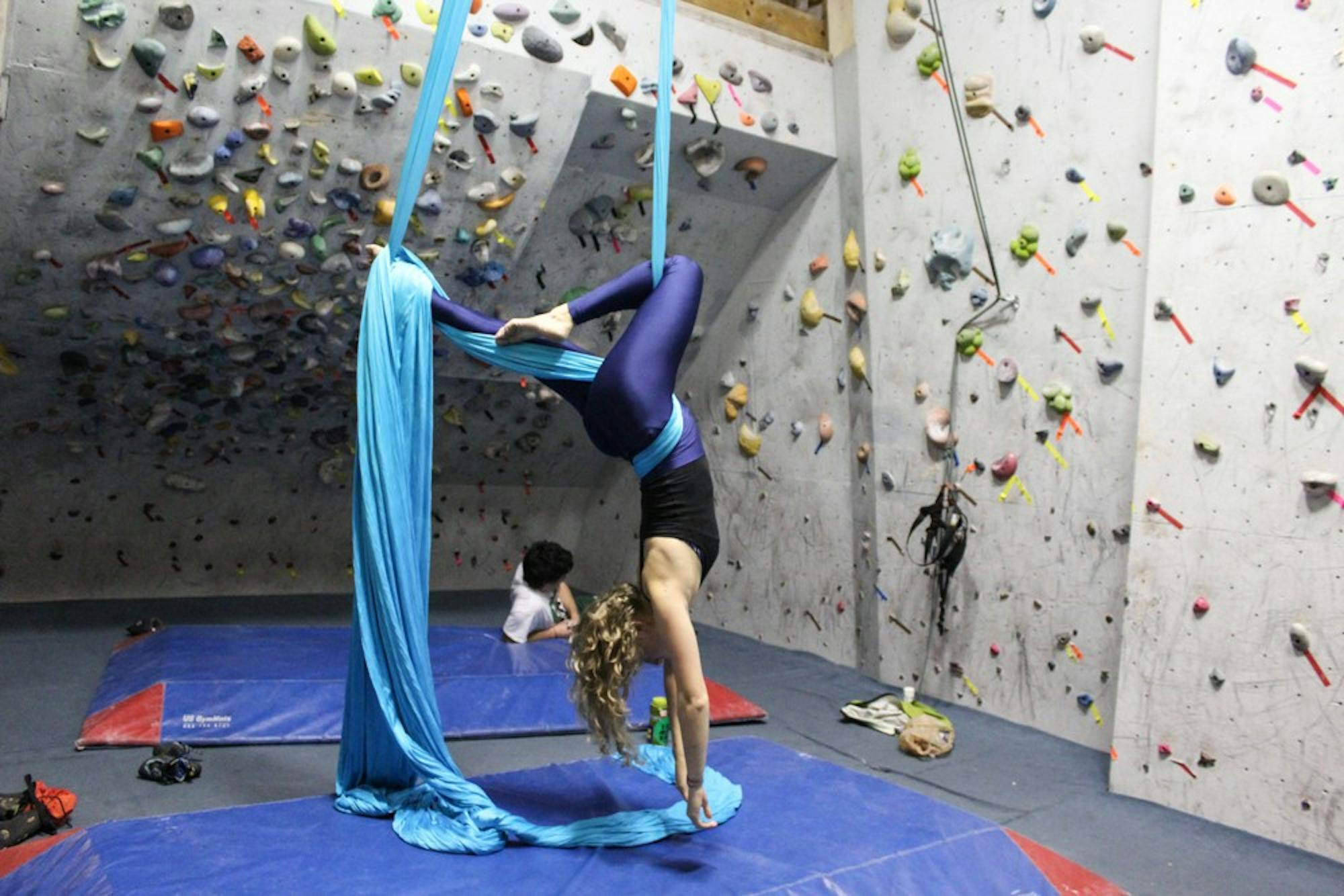When Cindy Li ’18 entered Dartmouth as a freshman, she was not ready to give up her high school hobby of aerial silks — so she set out to find others who were interested in the obscure mix of acrobatics and dance. Her search led her to a 2006 article in The Dartmouth about a now-defunct circus club called the Northern Lights, and from there, she was able to track down their last remaining member: Haley Reicher ’17. Since then, their group of aerial silk enthusiasts has grown to include Claire Apuan ’18 and Charlotte Nutt ’19. The Dartmouth climbing gym is home to this niche activity, which Apuan explained involves hanging a silk curtain from the ceiling on a special rigging device, but may not be the group’s first choice for a location.
“We have to work around the schedule of the climbing gym and can’t have the silks rigged all the time,” Reicher said. “So every time we gather, we have to get in harnesses and climb one of the ropes with the silks to rig them up, and then do that in reverse to bring them down.”
Apuan, who is a climber, usually rigs the silks when they practice.
The group is willing to deal with these inconveniences because they are not officially recognized by the College — but not for lack of trying.
“My sophomore fall, I actually tried to create an aerial arts club, but Collis didn’t approve it. They sent me to Risk Management, who were being really difficult and didn’t approve of it,” Li said. “So then I just gave up.”
The group’s inability to become a recognized group has resulted in some challenges. One such challenge is a lack of funding; Reicher said that she purchased silks and other necessary equipment — including a figure-8 hook, a rotating piece and two locking carabiners — online herself, and then put the equipment together to make a full aerial silk kit.
All of the girls except for Apuan had backgrounds in aerial silks prior to coming to Dartmouth. Reicher started aerial silks her sophomore year of high school at a circus studio in her hometown of Oakland, California. A friend from Nutt’s boarding school introduced her to silks. Li started doing silks her junior year of high school. Li convinced Apuan to join the group their sophomore spring because of Apuan’s involvement with the climbing gym.
The lack of recognition means that the group cannot publicly perform or openly advertise for new members. Li noted the difficulty in obtaining the College’s approval for a public performance.
“They think it’s dangerous to do silks,” Nutt said. “But I don’t think it’s dangerous; I’ve been doing it for three years now and I have never come close to injuring myself.”
However, the four group members expressed interest in getting others involved and possibly having a performance.
“I would love to do a performance on the Green sometime, maybe in the springtime when it’s beautiful outside,” Nutt said.
If the group were to do a performance outside, they would have a lot of preparation to do. It is difficult to find a place to rig silks that is also conducive as a performance space, Reicher said, and aerial silks require a high level of fitness and choreography. Apuan said that most routines are performed to pop music, but finding a song with a beat that works well with aerial silks can be challenging.
“It’s physically hard, and if you’re moving fast, it can be really exhausting,” Nutt said. “So you want a song with a slow beat and one that also changes speeds a little bit so you can fall into a drop or go slow if you want to.”
However, because the group is currently not recognized — Apuan calls them “casual” and “underground” — the pressure is off in regards to choreography and song choices.
“We don’t really perform here, we rig silks and do that for fun. We work on different climbs and different drops where you open yourself up in different ways and fall on purpose,” Reicher said. “It’s fun to do freestyle movement to music.”
They remain optimistic about the future of aerial silks at Dartmouth, despite the lack of recognition.
“I’m hoping some ’20s will find out about silks and get interested in it because it’s something of a niche activity here,” Reicher said. “But I think it’s really fun, and I hope more people realize it’s something that happens here and get involved.”




